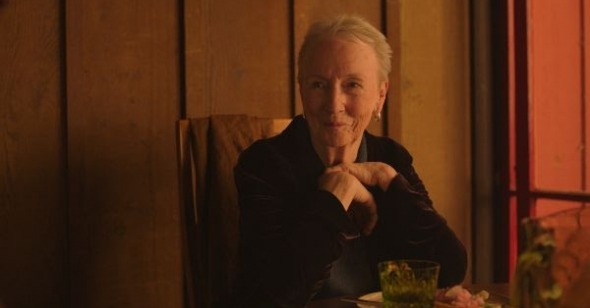Moving Through It
by Sarah Fensom
Familiar Touch
Dir. Sarah Friedland, U.S., Music Box Films
Familiar Touch, Sarah Friedland’s debut narrative feature about an octogenarian woman entering a full-time memory care facility, exists along the edges of the coming-of-age film. Ruth (Kathleen Chalfant), a chic Southern Californian, must manage new and pre-existing relationships within her changing circumstances and state-of-mind—much like her typically teenage counterparts in the genre. Friedland pulls many of the usual emotional levers—anger, rebellion, sexual angst, and the desire for freedom—but it’s set to the pace of Ruth’s life—how she moves, thinks, breathes. The film’s adagio rhythm doesn’t mean it’s sedate, however. Familiar Touch is a deeply kinetic work. Friedland, who is also a choreographer, infuses the film with graceful bodily gestures and overtures to the senses. In its bounty of movement and sensorial pleasures, it finds its compassionate voice—even though the memories of the life Ruth lived before she entered the care facility are slipping away, her body is still expressive, still free to actively experience being alive. It’s rare for a work of art about cognitive decline to focus on what is rather than what’s lost.
The film begins in Ruth’s sunny, well-appointed home, where she shuffles through hangers in her closet looking for what to wear. After finding the shirt she wants, she gives it a joyous hug. When we see her dressed, the shirt’s sumptuous tactility seems to jump off the screen—it’s in a dark hue of embraceable silk velvet. In her kitchen, she adroitly assembles what we learn is her “signature sandwich.” This woman’s life seems quietly luxurious and intentional, until we see her place a piece of toast on the dish rack. It’s a subtle cue that something is a bit off—a skip in the record. When her lunch partner, a middle-aged man named Steve (H. Jon Benjamin), arrives, and Ruth becomes flirty, his discomfort turns the skip into a full-on record scratch. Steve is Ruth’s son, but she doesn’t remember that. She thinks he’s taking her out somewhere, when in fact he’s driving her to her new residence—Bella Vista, a high-end assisted living home. Unaware, Ruth stretches out her hand for him to hold in the car, but it remains empty, filled only with sunlight.
Ruth repeats this gesture—her hand gracefully outstretched in space—a number of times during the film. Her opened hand juts into the frame as she plays a game on a VR headset with her fellow residents. Then, after removing the headset, she and a friend playfully repeat the gesture with both hands, as if pushing an invisible ball back and forth to each other. In the next scene, Ruth outstretches her palm while in the examination room with her doctor, Brian (Andy McQueen), so he can take her pulse at her wrist. She appears to be suffering a similar delusion as she did with Steve—confusing Brian’s care for romantic interest. At one point, we see her inverting the gesture, tenderly layering her palm over Brian’s as they silently stand together on an outdoor deck. Later, Ruth sits in the examination chair alone, inhaling deeply with her eyes closed in a trance-like state. She caresses her chest, before slowly outstretching her hand and sensuously taking her own pulse. The film’s narrative hangs loosely between individual moments in Ruth’s life at Bella Vista. It’s hard to tell how much time has elapsed between each incident or image. Yet, here, Ruth’s gestures build over time to subtly communicate the increasing severity of her dementia, with her inner narratives subsuming her connection to external reality.
Ruth’s repeated outstretched hand is similar to the one that opens Trisha Brown’s 1971 dance piece Accumulation. In Accumulation, a single dancer begins with a single gesture, adds another to it, and starts again from the beginning each time, performing the gestures in order. It is, essentially, a memory game. It’s also an apt lens through which to view Familiar Touch—Ruth’s gestures are built upon throughout its duration, creating a sort of dance. Chalfant is so committed that each state of being, mood, or memory Ruth seems to be stuck in can seem unshakeable and completely isolated from the others. When she is salty, she can’t remember how silly she was earlier, or, mistakenly believing she’s a little girl with her mother at the pool, she’s oblivious to the realities of Bella Vista and her caregivers there. Yet, a palpable throughline connects these accumulating gestures—a deeper, more physically hardwired sense of memory and persona.
Familiar Touch favors a straight-forward naturalism in its cinematography and performances. Dialogue is at a minimum, with the pointed looks and reactions of those around Ruth—Steve, Brian, and Vanessa (Carolyn Michelle Smith), her unfailingly patient and affable nurse—communicating sentiments and evaluations that the older woman is no longer able to pick up on. The film’s editing style obscures how long Ruth has been at Bella Vista, a device that effectively situates the viewer in the facility with her. In the penultimate scene, Steve comes to visit Ruth for a birthday party. We’ve barely seen him since the beginning of the film. In his appearances earlier, Benjamin is heartbreaking, but here, as the children of elderly parents often have to do, his character attempts to lighten the mood. He gets on the dance floor and does a silly shimmy that expands into a broader, goofier dance—one that highlights just how elegant many of the other movements in the film seem by comparison. He asks Ruth to dance, and she accepts. It’s a poignant moment: as the two of them move across the floor, they are finally able to communicate again.
